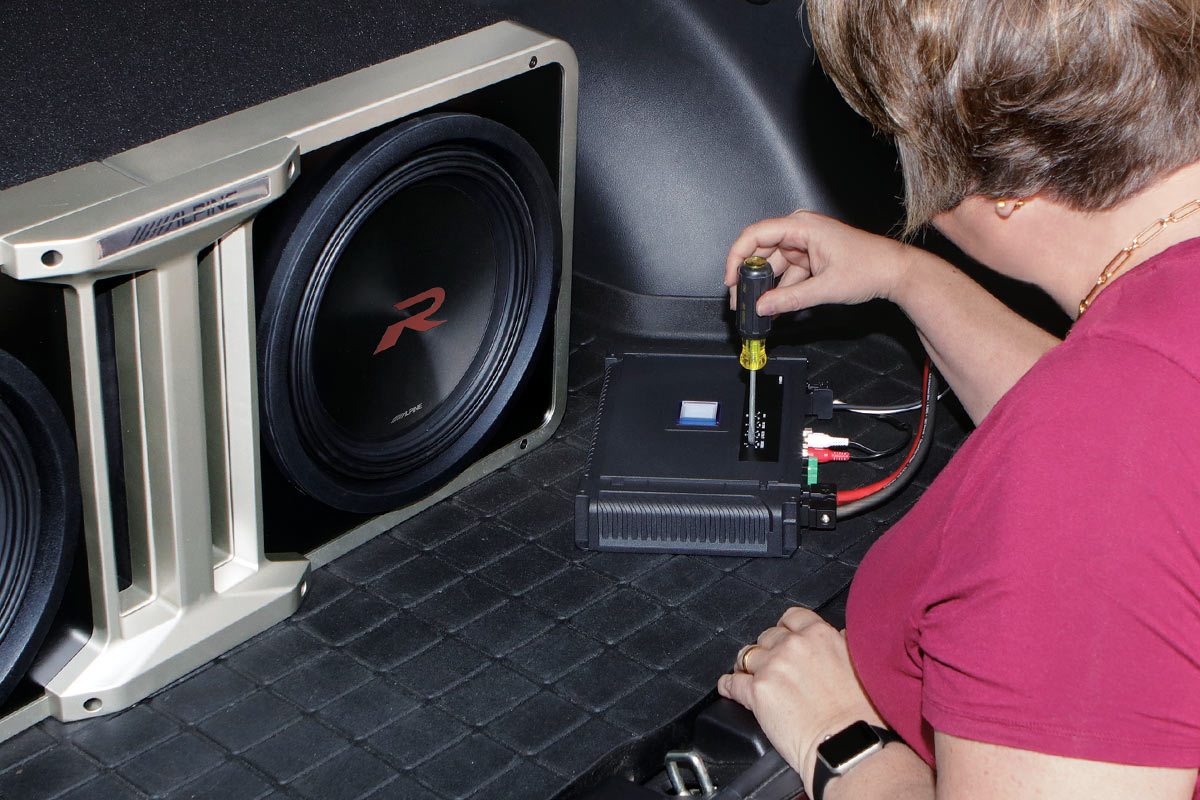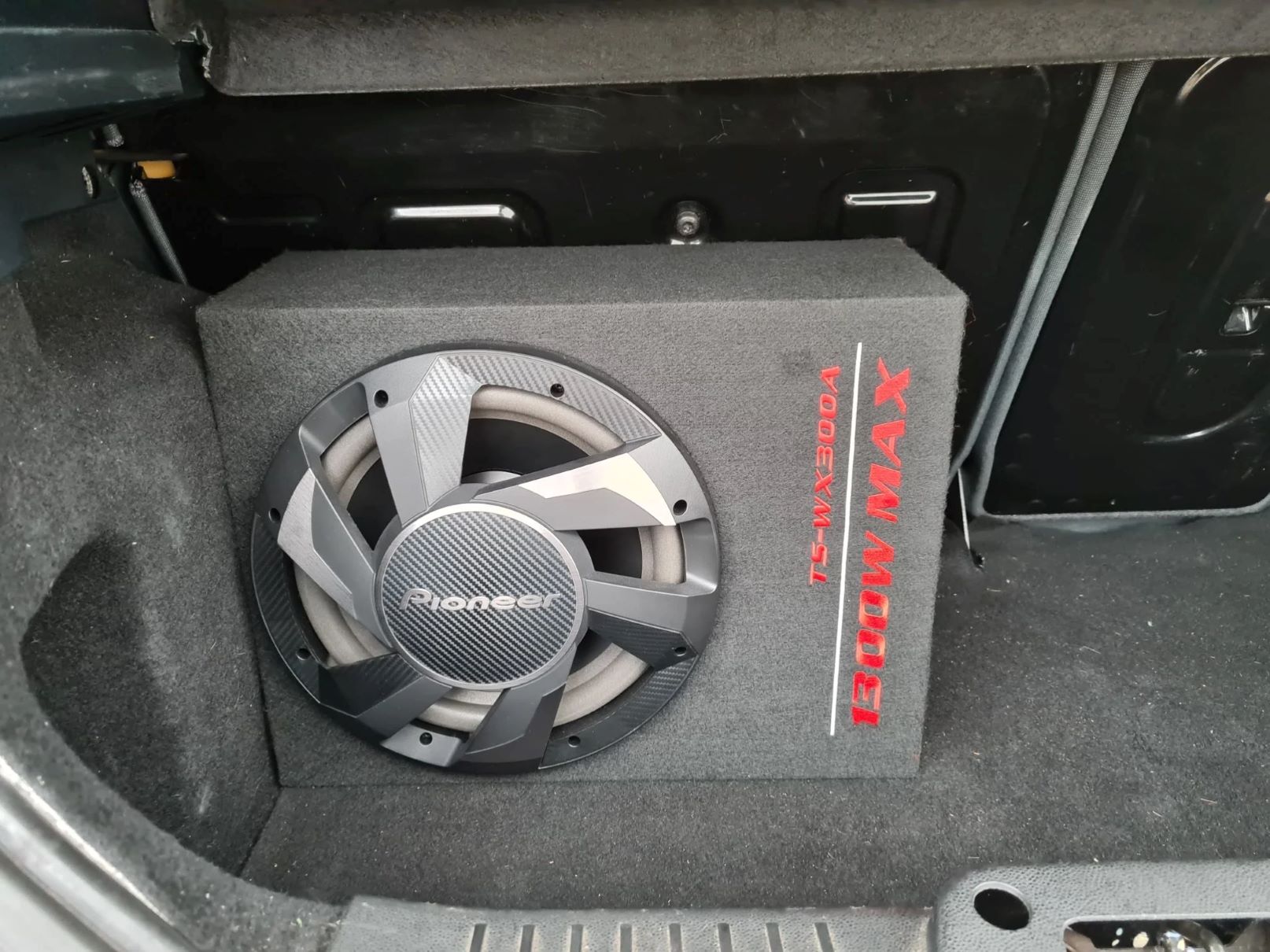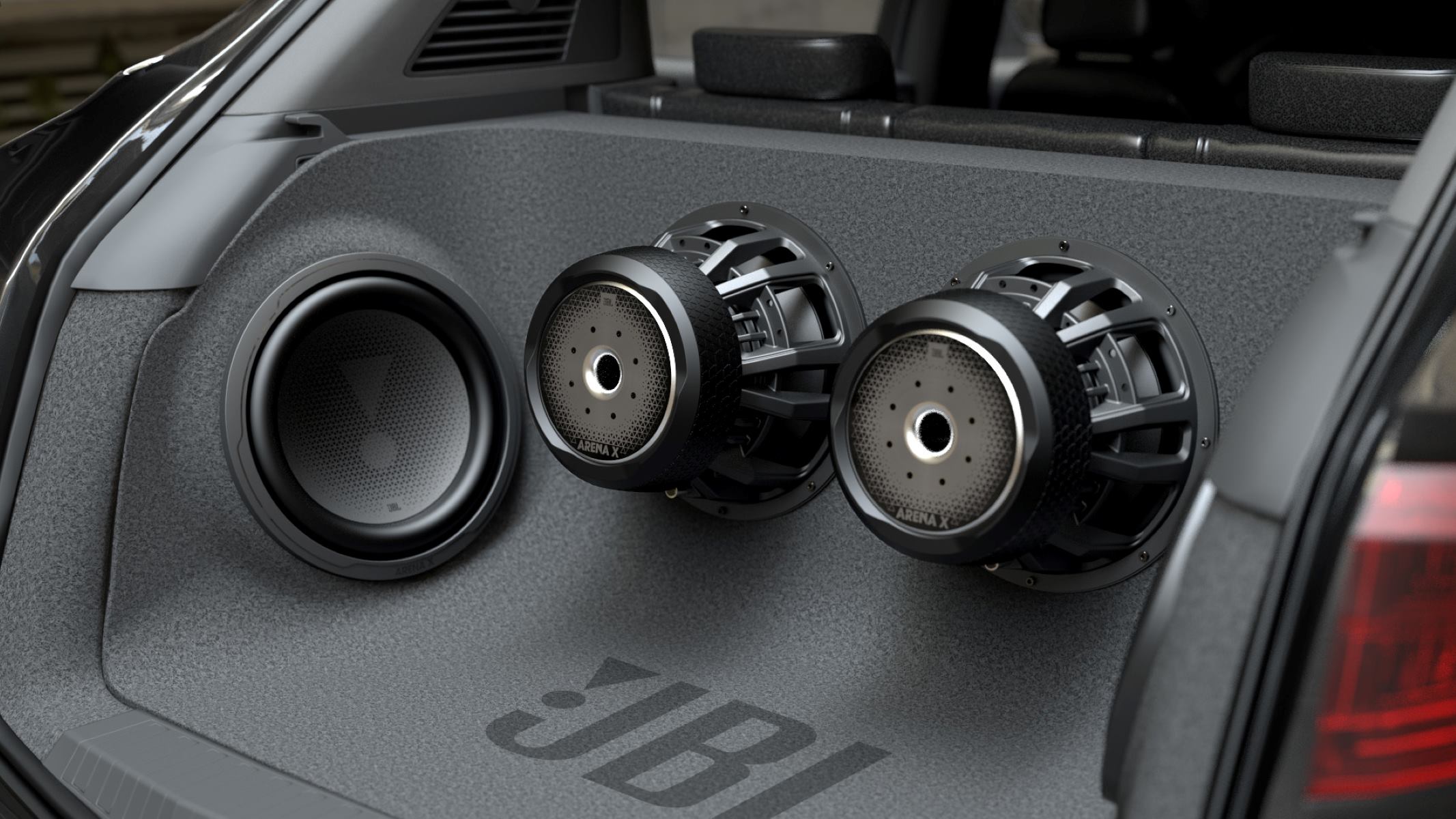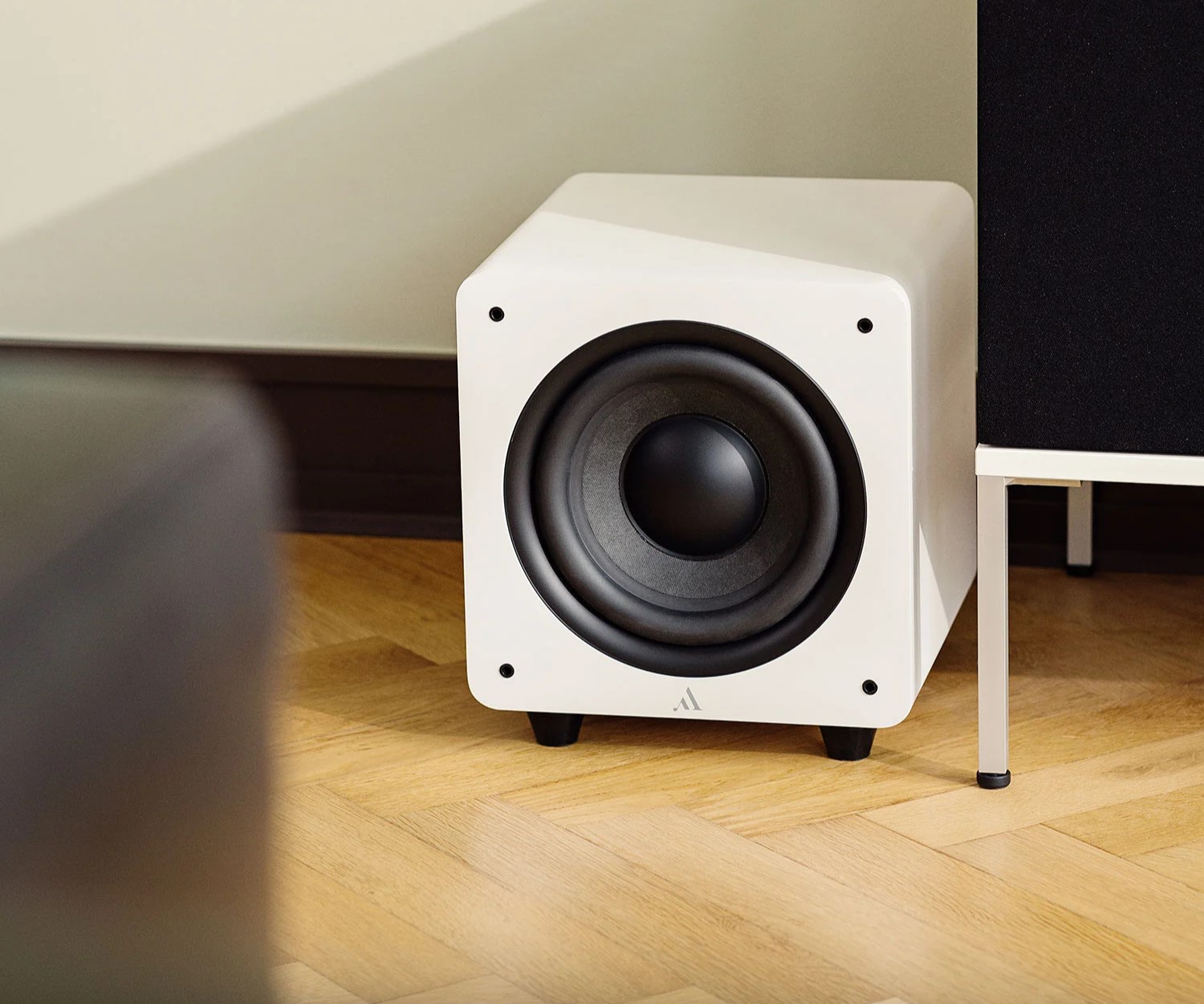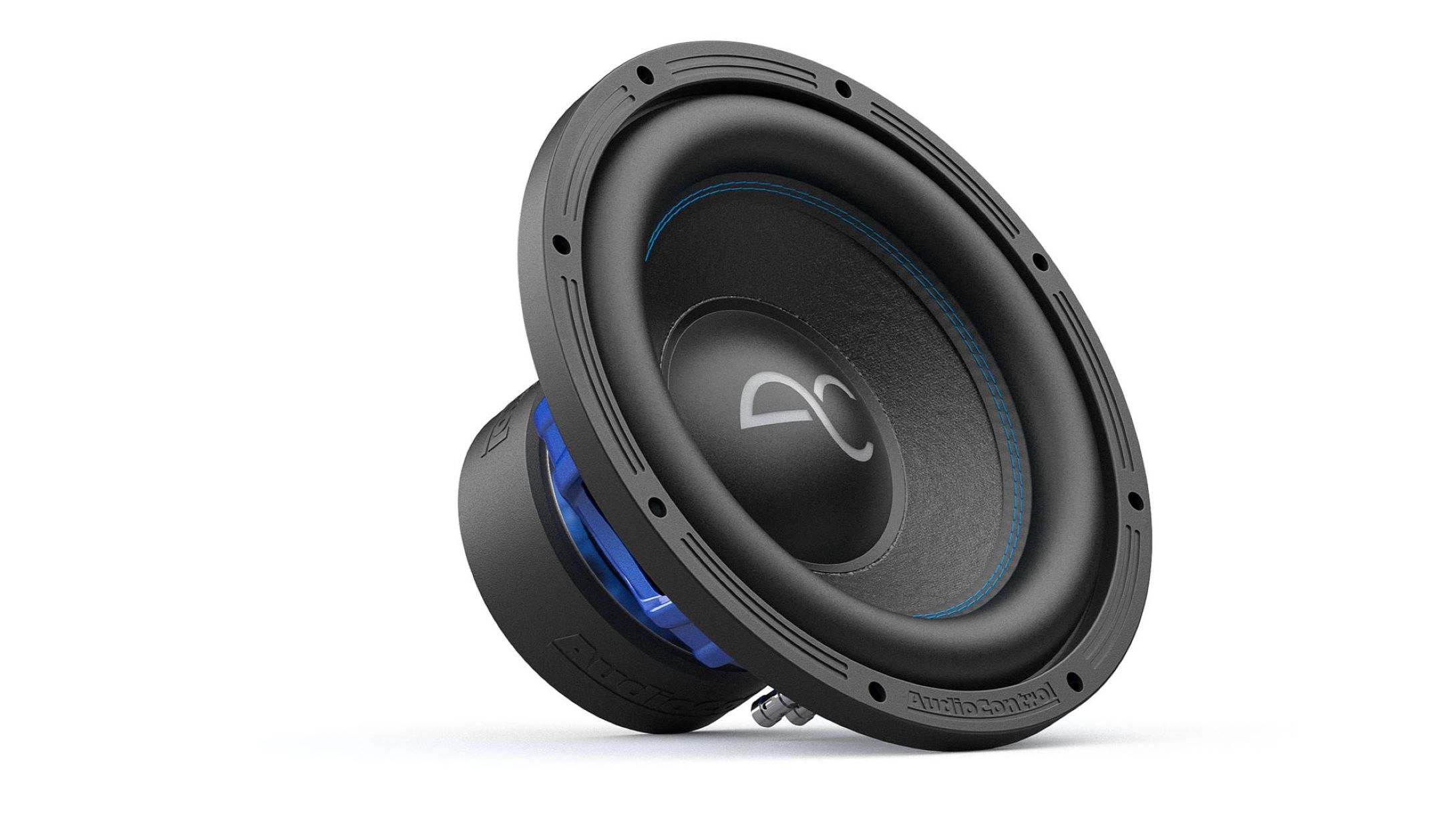Home>Devices & Equipment>Subwoofer>What Is A Subwoofer In A Car


Subwoofer
What Is A Subwoofer In A Car
Modified: February 18, 2024
Discover the power of a car subwoofer and elevate your audio experience. Unleash deep bass and enhance every beat with a quality subwoofer installation.
(Many of the links in this article redirect to a specific reviewed product. Your purchase of these products through affiliate links helps to generate commission for AudioLover.com, at no extra cost. Learn more)
Table of Contents
- Introduction
- Purpose of a Subwoofer in a Car
- How Does a Subwoofer Work?
- Benefits of Having a Subwoofer in a Car
- Different Types of Subwoofers for Cars
- Factors to Consider When Choosing a Car Subwoofer
- Installation and Placement of a Car Subwoofer
- Common Issues and Troubleshooting Tips for Car Subwoofers
- Maintenance and Care for Car Subwoofers
- Conclusion
Introduction
Welcome to the world of deep, immersive bass. In the quest for the ultimate car audio experience, one component plays a crucial role: the subwoofer. Whether you’re a music enthusiast or simply looking to enhance your driving pleasure, a subwoofer can make all the difference. But what exactly is a subwoofer and why is it so important in a car audio system? Let’s dive in and explore the wonderful world of car subwoofers.
A subwoofer is a specialized loudspeaker designed to reproduce low-frequency sound waves, typically below 200Hz. It is responsible for delivering those powerful, earth-shaking bass notes that add depth and impact to your music. Unlike regular speakers, which are optimized for mid-range and high-frequency sounds, subwoofers are specifically engineered to handle the low-end spectrum.
The primary purpose of a subwoofer in a car audio system is to reproduce low-frequency sounds accurately and with precision. While the main speakers in your car can handle mid and high-frequency ranges quite well, they often lack the ability to reproduce deep bass. This is where a subwoofer comes in, filling in the missing pieces of the audio puzzle and providing a rich, full-bodied sound experience.
When it comes to music genres like hip-hop, EDM, or any other genre that heavily relies on bass, a subwoofer can truly transform your listening experience. The pounding basslines, rumbling drums, and chest-thumping beats become more pronounced, adding a new dimension to the music. Not only does it make the audio more engaging, but it also allows you to feel the music in a way that standard speakers simply cannot deliver.
But a car subwoofer is not just about music. It also plays an important role in enhancing the overall audio quality in your car. By offloading the low-frequency sounds to a separate subwoofer, the main speakers are relieved of the task, allowing them to focus on delivering cleaner and more accurate mid-range and high-frequency sound reproduction. This leads to a more balanced and immersive listening experience.
In the next sections, we will delve deeper into the mechanics and benefits of having a subwoofer in a car audio system. From understanding how subwoofers work to exploring the different types available and the factors to consider when choosing one, this article will equip you with the knowledge you need to make informed decisions when it comes to integrating a subwoofer into your car audio setup.
Purpose of a Subwoofer in a Car
Imagine driving down the road, your favorite song playing in the background. As you turn up the volume, you notice something missing – the deep, powerful bass that brings the music to life. This is where a subwoofer comes in. The purpose of a subwoofer in a car is to reproduce low-frequency sounds accurately and enhance the audio experience by adding depth, impact, and realism to the music.
One of the primary reasons for installing a subwoofer in your car is to fill in the low-frequency spectrum that regular speakers are not designed to handle. Most car audio systems consist of speakers designed to reproduce mid and high-range frequencies. While they can produce decent sound quality in these ranges, they often lack the ability to deliver the deep, rumbling bass that adds a new dimension to the music.
A subwoofer focuses on the lower end of the audio spectrum, typically ranging from 20Hz to 200Hz. By dedicating a specialized speaker to handle these frequencies, you can enjoy a more well-rounded and immersive audio experience in your car. The subwoofer works in sync with the main speakers to provide a full range of sound, bringing out the depth and impact in music genres like hip-hop, EDM, and rock where the bass plays a crucial role.
Not only does a subwoofer enhance the musical experience, but it also improves the overall audio quality in your car. By taking on the task of reproducing low-frequency sounds, the subwoofer allows the main speakers to focus on delivering cleaner and more accurate mid-range and high-frequency sound. This results in a more balanced and detailed audio output.
In addition to music, a subwoofer is also beneficial for movies, podcasts, and other audio content you may enjoy while on the road. It adds depth and realism to explosions, thumps, and other low-frequency effects, making the audio more engaging and lifelike. Whether you’re watching a movie in your car or simply enjoying your favorite podcast, a subwoofer can greatly enhance the entertainment value.
Furthermore, if you’re someone who appreciates a well-tuned sound system, a subwoofer is a crucial component for achieving the audio quality you desire. It allows you to fine-tune the frequency response and sound signature of your car audio system, creating a personalized listening experience tailored to your preferences.
In the next sections, we will explore how a subwoofer works, the different types available, and the factors to consider when choosing one for your car. So buckle up and get ready to immerse yourself in the world of bass.
How Does a Subwoofer Work?
Have you ever wondered how a subwoofer is able to produce those deep, powerful bass notes that resonate within you? The inner workings of a subwoofer are fascinating and integral to its ability to reproduce low-frequency sounds accurately. Let’s take a closer look at how a subwoofer works.
At the heart of a subwoofer is a specialized speaker driver known as a woofer. Unlike regular drivers found in standard speakers, a woofer is specifically designed to handle low-frequency sounds. It consists of a large cone or diaphragm that moves back and forth rapidly in response to the audio signal it receives.
When an electrical signal is sent to the subwoofer, it passes through the amplifier and reaches the voice coil of the woofer. The voice coil is a wire coil that is attached to the apex of the woofer cone. As the signal passes through the voice coil, it generates a magnetic field that interacts with a stationary magnet within the subwoofer.
This interaction between the magnetic field and the voice coil causes the coil and the attached woofer cone to move back and forth. This movement creates changes in air pressure, which in turn generates sound waves. The size of the woofer cone, as well as its excursion capabilities, determines the volume and intensity of the bass produced by the subwoofer.
In addition to the mechanical components, a subwoofer also includes an enclosure, or box, that houses the driver. The enclosure plays a crucial role in the subwoofer’s performance by controlling the airflow and ensuring optimal sound reproduction. There are various types of enclosures, including sealed, ported (also known as bass reflex), and bandpass, each offering different acoustic characteristics and bass responses.
Furthermore, subwoofers are often accompanied by a crossover network. This network filters and directs the correct frequencies to the subwoofer, allowing it to focus on reproducing the low-frequency sounds it is designed for. This helps to ensure that each speaker in the car audio system performs its designated range efficiently and accurately.
Overall, a subwoofer works by converting electrical signals into mechanical vibrations, which in turn generate sound waves that we perceive as deep bass. Its specialized design and enclosure enable it to handle low-frequency sounds with precision, enhancing the audio experience in your car.
In the following sections, we will explore the benefits of having a subwoofer in your car, the different types of subwoofers available, and the factors to consider when choosing one for your car audio setup.
Benefits of Having a Subwoofer in a Car
When it comes to car audio systems, a subwoofer is not just a luxury addition; it offers several benefits that can greatly enhance your overall listening experience. Let’s take a closer look at the advantages of having a subwoofer in your car.
1. Enhanced Bass Response: The most obvious benefit of a subwoofer is the ability to reproduce deep, powerful bass notes that you can feel. The subwoofer’s specialized design and dedicated focus on low-frequency sounds allow it to reproduce bass with accuracy and impact, bringing your music to life in a way that regular speakers cannot.
2. Improved Audio Quality: By adding a subwoofer to your car audio system, you can achieve a more balanced and refined audio output. Offloading the low-frequency sounds to a dedicated subwoofer allows the main speakers to focus on delivering cleaner and more accurate mid-range and high-frequency sound. This leads to improved clarity, detail, and overall sound quality.
3. Immersive Listening Experience: Whether you’re listening to music, watching a movie, or enjoying a podcast, a subwoofer adds depth and realism to the audio, creating a more immersive experience. It allows you to feel the impact of explosions, the rumble of a deep bass guitar, or the thumping beats of electronic music. It brings the sound to life, making you feel like you’re right in the middle of the action.
4. Versatile Sound Reproduction: A subwoofer is not just limited to enhancing the bass in music. It can also improve the overall audio performance when it comes to movies, podcasts, and other forms of entertainment. The deep bass reproduction adds depth and impact to explosions, dialogue, and other low-frequency effects, making the audio more engaging and lifelike.
5. Customizable Sound Signature: If you’re someone who values a personalized audio experience, a subwoofer allows you to fine-tune the sound signature of your car audio system. With adjustable settings such as crossover frequency, gain, and phase, you can tailor the bass response to your preferences and create a listening experience that suits your musical tastes.
6. Increased Sound Pressure: Subwoofers are designed to handle high power levels, allowing them to produce higher sound pressure levels compared to regular speakers. This means that even at high volumes, the bass remains punchy and controlled, without distortion or loss of detail. It ensures that your music maintains its impact and clarity, even in demanding listening situations.
7. Adds Value to Your Vehicle: Installing a subwoofer in your car can increase its resale value. Car audio enthusiasts and potential buyers often look for vehicles with a well-integrated and high-quality audio system. Having a subwoofer as part of your setup can make your car more appealing and desirable in the market.
In summary, the benefits of having a subwoofer in your car include enhanced bass response, improved audio quality, an immersive listening experience, versatility in sound reproduction, customizable sound signature, increased sound pressure, and added value to your vehicle. So why settle for ordinary sound when you can experience extraordinary bass with a subwoofer?
Next, we will delve into the different types of subwoofers available for cars, helping you choose the one that best suits your needs and preferences.
Different Types of Subwoofers for Cars
The world of subwoofers offers a variety of options to suit different preferences and car audio setups. Understanding the different types of subwoofers available can help you make an informed decision when choosing the right one for your car. Let’s explore the various types of subwoofers for cars.
1. Component Subwoofers: Component subwoofers consist of a separate woofer driver and enclosure. They offer the advantage of customization, allowing you to select a woofer driver with the desired specifications and pair it with an enclosure that suits your car’s available space. Component subwoofers are ideal for those who want to fine-tune their audio system and have more control over the sound output.
2. Enclosed Subwoofers: Enclosed subwoofers are pre-mounted in a sealed or ported enclosure. They are a convenient and straightforward solution for adding bass to your car audio system as they come ready to install. Enclosed subwoofers are a popular choice for those seeking a quick and hassle-free upgrade without the need for building or selecting separate components.
3. Powered Subwoofers: Powered subwoofers combine the subwoofer driver and amplifier in one unit. They are self-contained and come with a built-in amplifier specifically designed to power the subwoofer. Powered subwoofers are an ideal choice for those who want to add bass to their car audio system but have limited space or want a simplified installation process.
4. Vehicle-Specific Subwoofers: Some car audio manufacturers offer subwoofers that are specifically designed to fit seamlessly into certain vehicle models. These subwoofers are custom-tailored to match the available space and power requirements of the vehicle, ensuring a perfect integration and optimized performance. Vehicle-specific subwoofers are an excellent option for those who prioritize a clean and factory-like installation.
5. Shallow-Mount Subwoofers: Shallow-mount subwoofers are designed to fit in tight spaces with limited depth. They feature slim profiles without compromising on sound quality, making them suitable for vehicles with limited installation options. Shallow-mount subwoofers are a great choice for compact cars or vehicles with limited trunk space.
6. Passive Radiator Subwoofers: Passive radiator subwoofers are similar to regular subwoofers but with an additional passive radiator instead of a traditional port. The passive radiator is a diaphragm that moves in response to air pressure changes created by the main woofer. This design enhances bass response and can result in cleaner and more controlled bass reproduction.
7. Bandpass Subwoofers: Bandpass subwoofers feature a specifically designed enclosure that is divided into two chambers. One chamber houses the subwoofer driver, while the other acts as a resonator. This design allows for increased efficiency and can result in louder and more intense bass output. Bandpass subwoofers are a popular choice for those seeking maximum bass impact.
When selecting a subwoofer for your car, consider factors such as available space, desired sound quality, power requirements, and installation convenience. It’s also essential to match the subwoofer’s specifications with your car audio system’s capabilities to ensure optimal performance.
In the next section, we will discuss the crucial factors to consider when choosing a subwoofer for your car audio setup. By understanding these factors, you can make an informed decision and select a subwoofer that meets your specific requirements.
Factors to Consider When Choosing a Car Subwoofer
Choosing the right subwoofer for your car audio system is essential to achieve the desired bass performance and overall audio quality. With various options available, it’s important to consider several factors before making a decision. Let’s explore the key factors to consider when choosing a car subwoofer.
1. Power Handling: Power handling is an important specification to consider as it determines the amount of power the subwoofer can handle. It is measured in watts and usually presented in two values: RMS (Root Mean Square) power handling and peak power handling. RMS power handling is a more accurate representation of the subwoofer’s continuous power capability, while peak power handling indicates its maximum power handling capacity.
2. Sensitivity: Sensitivity refers to how efficiently the subwoofer converts power into sound. It is measured in decibels (dB) and indicates the loudness of the subwoofer at a specified power level. Generally, subwoofers with higher sensitivity require less power to achieve the same volume level as subwoofers with lower sensitivity. Choosing a subwoofer with a higher sensitivity rating can help maximize the performance of your car audio system.
3. Frequency Response: The frequency response of a subwoofer specifies the range of frequencies it can reproduce. The ideal frequency response for a car subwoofer is typically between 20Hz to 200Hz, which covers the low bass frequencies. Look for a subwoofer that can accurately reproduce the frequencies within your desired range, ensuring that it complements the frequency response of your main speakers.
4. Enclosure Type: The type of enclosure used with the subwoofer can significantly impact its performance. The two primary types of enclosures are sealed and ported. Sealed enclosures provide tight and accurate bass, while ported enclosures enhance low-end output and can produce louder bass. Consider the space available in your car, your listening preferences, and the type of music you enjoy to determine which enclosure type suits your needs best.
5. Size and Fit: The size of the subwoofer and its compatibility with your car’s available space are crucial factors to consider. Subwoofers come in various sizes, such as 8-inch, 10-inch, 12-inch, and larger. Larger subwoofers generally produce more bass but require more space for installation. Measure the available space in your car to ensure that the subwoofer you choose will fit properly and won’t interfere with other components or cargo.
6. Build Quality: The build quality of a subwoofer can greatly impact its durability and overall performance. Look for subwoofers with solid construction, sturdy materials, and high-quality components. A well-built subwoofer can handle the demands of low-frequency reproduction and withstand prolonged use without experiencing distortion or damage.
7. Brand Reputation and Reviews: It’s beneficial to consider the reputation of the brand and read reviews from other customers before making a purchase. Well-established brands with a proven track record of producing reliable and high-performing subwoofers are more likely to deliver a satisfying audio experience. Customer reviews can provide insight into real-world experiences and help you make an informed decision.
By considering these factors and matching them with your specific requirements and preferences, you can choose a car subwoofer that meets your needs and enhances your audio system. Taking the time to research and select the right subwoofer will ensure optimal bass performance and deliver an immersive listening experience.
In the next section, we will dive into the installation and placement considerations for a car subwoofer, helping you achieve the best sound quality and bass reproduction in your vehicle.
Installation and Placement of a Car Subwoofer
Proper installation and placement of a car subwoofer are crucial to optimize its performance and achieve the best sound quality. Here are some important considerations when it comes to installing and placing a car subwoofer:
1. Choosing the Right Location: The location of the subwoofer in your car can greatly impact its bass output and overall sound quality. The most common placement options include the trunk, rear seat area, or under a seat. Consider the available space in your vehicle, as well as the type and size of the subwoofer you have chosen, to determine the optimal location for installation.
2. Subwoofer Enclosure Type: The type of enclosure you choose for your subwoofer will also impact its placement options. Sealed enclosures are more forgiving in terms of placement and can typically be installed in various locations. Ported enclosures, on the other hand, require specific placement considerations to ensure they function optimally and produce the desired bass response.
3. Subwoofer Orientation: The orientation of the subwoofer within the enclosure can affect its performance. If you have a standard subwoofer, positioning it so that the cone faces towards the rear of the vehicle can help enhance bass response. However, for specific subwoofer designs, such as down-firing or front-firing, it’s important to follow the manufacturer’s recommendations for orientation.
4. Wiring and Connection: Proper wiring and connection are essential for optimal performance and safety. Follow the manufacturer’s instructions for the correct gauge of wire to use and ensure secure connections. It’s important to connect the subwoofer to a dedicated amplifier or an amplifier channel capable of powering it effectively.
5. Integration with Existing Audio System: Ensuring that the subwoofer integrates seamlessly with your existing car audio system is crucial for a balanced and cohesive sound experience. Set appropriate crossover settings to direct the low-frequency signals to the subwoofer, while the mid-range and high-frequency signals are directed to the main speakers. Additionally, adjust the gain and phase settings to achieve a smooth transition between the subwoofer and the main speakers.
6. Sound Deadening and Enclosure Sealing: To minimize unwanted vibrations and improve bass response, consider investing in sound deadening materials for your vehicle’s interior. Additionally, ensure that the subwoofer enclosure is properly sealed to prevent air leaks that can impact the performance and efficiency of the subwoofer.
7. Professional Installation: If you’re unsure about the installation process or want to ensure the best possible results, it’s recommended to seek professional installation services. Professional installers have the expertise and knowledge to handle the intricacies of installing a subwoofer, ensuring proper placement, wiring, and integration with your car audio system.
Remember, every car and audio system is unique, so experimentation may be necessary to achieve the best sound quality and bass response. Taking the time to properly install and place your subwoofer will greatly enhance your overall car audio experience, immersing you in deep, powerful bass that complements your favorite music genres.
In the next section, we will discuss common issues that may arise with car subwoofers and provide troubleshooting tips to address them effectively.
Common Issues and Troubleshooting Tips for Car Subwoofers
While car subwoofers can greatly enhance your audio experience, it’s not uncommon to encounter some issues along the way. Thankfully, most problems can be resolved with some troubleshooting. Here are some common issues you may encounter with car subwoofers and tips to address them:
1. No Sound or Low Volume: If your subwoofer is not producing any sound or the volume is too low, check the connections first. Ensure that the subwoofer is properly connected to the amplifier or head unit. Confirm that the amplifier or head unit is powered on and the volume is turned up. Additionally, check the settings on the crossover and gain controls to ensure they are properly adjusted for the desired volume and frequency response.
2. Distorted or Muddy Bass: If the bass from your subwoofer sounds distorted or muddy, it may be due to incorrect settings or an inadequate power supply. Check the gain settings on the amplifier and make sure they are properly balanced to avoid overdriving the subwoofer. If necessary, adjust the crossover frequency to achieve a smoother transition between the subwoofer and main speakers. Double-check that your power supply can deliver sufficient power to the amplifier and subwoofer without voltage drops.
3. Rattling or Vibrating Sounds: Rattling or vibrating sounds can result from loose connections, poorly secured components, or resonance within the vehicle. Check and tighten all connections, including the speaker wires, enclosure, and mounting brackets. Inspect the area around the subwoofer to ensure there are no loose objects that may be causing vibration. Consider using damping materials like foam or rubber pads to minimize rattling and vibrations in key areas of the vehicle.
4. Overheating: Overheating can occur if the subwoofer is being pushed too hard or if it is not receiving adequate airflow. Ensure that the amplifier is not being operated at maximum power for extended periods, as this can cause overheating. Check that the subwoofer is properly ventilated and not obstructed by items in the trunk or under the seats. Consider installing fans or placing the subwoofer in a cooler location, if possible, to improve airflow and prevent overheating.
5. Poor Integration with Main Speakers: If the subwoofer is not blending well with the main speakers, adjust the crossover settings to achieve a smoother transition between the two. Experiment with different crossover frequencies to find the optimal point where the subwoofer complements the main speakers without overpowering them. Adjust the phase control if necessary to align the timing of the subwoofer’s output with that of the main speakers, resulting in improved integration and a more cohesive soundstage.
6. Fuse Blown or Circuit Protection Engaged: If the subwoofer suddenly stops working and the amplifier’s fuse blows or the circuit protection engages, it may indicate a power-related issue. Verify that the subwoofer and amplifier combination is compatible in terms of power requirements. Ensure that your power and ground connections are secure and that your wiring is of adequate gauge to handle the power demand. If the issue persists, consult a professional to avoid further damage to your equipment.
7. Professional Assistance: In some cases, troubleshooting may require professional assistance, especially if you’re unable to identify the root cause of the problem or if you’re uncomfortable working with electrical components. Professional installers and audio technicians have the expertise to diagnose and resolve complex issues related to your car subwoofer system.
By following these troubleshooting tips, you can address common issues that may arise with your car subwoofer system. Remember to double-check the settings, connections, and compatibility of your components to ensure optimal performance and a satisfying bass experience.
Lastly, in the final section, we will discuss maintenance and care tips to prolong the lifespan of your car subwoofer and maintain its optimal performance.
Maintenance and Care for Car Subwoofers
To ensure that your car subwoofer continues to deliver optimal performance and longevity, proper maintenance and care are essential. Here are some maintenance tips to keep your car subwoofer in top shape:
1. Regular Cleaning: Dust and debris can accumulate on the surface of the subwoofer and affect its performance. Use a soft microfiber cloth or brush to gently wipe away any dust or dirt from the subwoofer’s cone, surround, and enclosure. Avoid using abrasive or harsh cleaners, as they can cause damage to the subwoofer’s materials.
2. Check and Tighten Connections: Regularly inspect the connections between the subwoofer, amplifier, and head unit. Ensure that all wires and terminals are securely connected and tightened. Loose connections can result in poor performance and potentially cause damage to the subwoofer or amplifier. Additionally, check the power and ground connections to ensure they are secure and free from corrosion.
3. Monitor for Signs of Damage: Keep an eye out for any signs of damage or wear on the subwoofer. Look for tears or punctures in the cone, surround, or enclosure. If you notice any damage, it’s best to address it promptly to prevent further deterioration or performance issues. Contact a professional if you require repairs or replacements for damaged components.
4. Protect from Moisture and Extreme Temperatures: Exposure to moisture can damage the subwoofer, so it’s important to protect it from rain, humidity, or any other source of water. If your subwoofer is installed in an area prone to moisture, consider using a protective cover or enclosure. Additionally, avoid exposing the subwoofer to extreme temperatures, as this can cause damage to the materials and affect performance.
5. Mindful Use: Be mindful of how you use your subwoofer to prevent potential issues. Avoid excessively cranking up the volume or pushing the subwoofer above its recommended limits for extended periods. Overpowering or overdriving the subwoofer can lead to distortion, overheating, or even damage to the cone or voice coil. Use the subwoofer within its specified power range to ensure longevity and optimal performance.
6. Secure Enclosure: If your subwoofer is installed in an enclosure, periodically check and tighten the screws or bolts holding the enclosure together. Vibrations from the bass output can loosen fasteners over time, affecting the overall performance and sound quality. Regularly inspect and tighten the enclosure to maintain a secure and stable setup.
7. Professional Maintenance: If you’re unsure about any maintenance procedures or encounter issues beyond your expertise, it’s best to consult a professional. Experienced installers and audio technicians can provide expert advice, perform maintenance tasks, and address any complex issues with your car subwoofer system.
By following these maintenance and care tips, you can ensure that your car subwoofer remains in optimal condition and provides you with the best bass experience for years to come. A well-maintained subwoofer will continue to enhance your audio system and keep you grooving to deep, satisfying bass.
With that, we come to the end of our comprehensive guide to car subwoofers. We have explored their purpose, how they work, the benefits they offer, different types available, factors to consider when choosing one, installation and placement considerations, common issues, and troubleshooting tips, as well as maintenance and care. Armed with this knowledge, you can confidently select, install, and maintain a car subwoofer that will elevate your driving experience with deep, immersive bass.
Conclusion
Car subwoofers are an invaluable addition to any car audio system, providing deep, immersive bass that elevates your music listening experience. They are specially designed to reproduce low-frequency sounds with accuracy and impact, filling your vehicle with powerful, earth-shaking bass notes.
Throughout this comprehensive guide, we have explored the purpose of a subwoofer in a car, how it works, the benefits it offers, different types available, factors to consider when choosing one, installation and placement considerations, common issues, and troubleshooting tips, as well as maintenance and care.
From enhancing bass response and improving overall audio quality to creating an immersive listening experience and offering customization options, subwoofers play a vital role in delivering the best sound quality in your car. Whether you’re a music enthusiast craving for deeper bass or someone who appreciates a well-balanced audio system, a subwoofer can significantly enhance your driving pleasure.
When selecting a subwoofer, consider factors such as power handling, sensitivity, frequency response, enclosure type, size, and fit. Proper installation and placement of the subwoofer, along with careful wiring and integration with the existing audio system, ensure optimal performance and a cohesive sound experience.
It’s important to troubleshoot common issues that may arise with car subwoofers, such as no sound, distorted bass, rattling sounds, and overheating. By following troubleshooting tips and seeking professional assistance when needed, you can address these issues and maintain the performance of your subwoofer.
Maintaining and caring for your car subwoofer is essential to ensure its longevity and optimal performance. Regular cleaning, checking and tightening connections, monitoring for signs of damage, and protecting the subwoofer from moisture and extreme temperatures are key maintenance practices to follow.
By following the information and tips provided in this guide, you can confidently select, install, troubleshoot, and maintain a car subwoofer that will deliver exceptional bass performance and elevate your driving experience. So, embrace the world of deep, immersive bass and enjoy a whole new dimension of sound in your car.

